Faith and Evidence in
the Witness of Ancient Texts for the Book of Moses Enoch Story
by Jeffrey M. Bradshaw
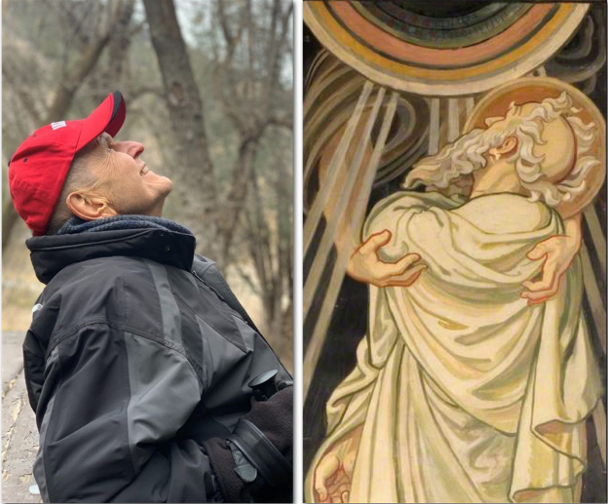
21 And the bow shall be in the cloud; and I will look upon it, that I may remember the everlasting covenant, which I made unto thy father Enoch; that, when men should keep all my commandments, Zion should again come on the earth, the city of Enoch which I have caught up unto myself.
22 And this is mine everlasting covenant, that when thy posterity shall embrace the truth, and look upward, then shall Zion look downward, and all the heavens shall shake with gladness, and the earth shall tremble with joy;
I hope no one will take this as a hidden prophecy that President Nelson is soon to be translated. Rather my hope is that in reading and applying his message and the lessons of the story of the city of Enoch we will remember that the glorious day of the return of heavenly Zion to the earth depends on the degree to which each of us individually “embrace the truth and look upward” (JST Genesis 9:22).
Joseph Smith and Ancient Enoch Texts
To me, the truth of the eventual return of Enoch’s city to the earth is not a mere hope, but a reality—something as real to me as my daily existence. My testimony of the divine provenance of the Book of Moses, as with every other facet of my testimony in the Restored Gospel, comes from the realm of faith and personal experience.[4] That said, study and research have played an important, though admittedly secondary role in my testimony.
If the ultimate answers come from faith, why bother with scholarship at all? For one thing, I am persuaded that competent wielding of the tools of scholarship can be of immense value in increasing our understanding of both ancient and modern scripture. Moreover, we see no reason why the same methods of comparative scholarship that are sometimes employed to argue that Joseph Smith used 19th-century sources as aids in translation cannot also be used to discover ancient affinities to modern scripture. While such arguments are not the sine qua non of the believer’s testimony, they have their place in cracking open by a hair the doors of faith for a skeptical world. Elder Jeffrey R. Holland has said:[5]
Our testimonies aren’t dependent on evidence—we still need that spiritual confirmation in the heart … but not to seek for and not to acknowledge intellectual, documentable support for our belief when it is available is to needlessly limit an otherwise incomparably strong theological position and deny us a unique, persuasive vocabulary in the latter-day arena of religious investigation and sectarian debate. Thus armed with so much evidence …, we ought to be more assertive than we sometimes are in defending our testimony of truth.
In my lifetime love affair with the Book of Moses, I have found not only spiritual nourishment in the central doctrines of the Gospel but also enjoyed the great pleasure of studying ancient texts that confirm and complete my understanding of the stories and truths of modern scripture. Many Latter-day Saints will be familiar with Hugh Nibley’s remarkable discoveries in ancient documents relating to the Book of Moses story of Enoch that were published nearly fifty years ago.[6] However, they may not be aware that the flow of significant new discoveries has not abated. For example, newly analyzed passages from the ancient Book of Giants confirm the Latter-day Saint account of Enoch’s gathering of Zion and the eventual ascent of his people to heaven—items whose full significance in the ancient literature have only come to light in the last decade. In addition, based on the recent discovery of the Manichaean Cosmology Painting—a work that contains detailed illustrations of Enoch’s story—we now have some idea of the symbolic geography of Enoch’s travels, likely portraits of individuals to whom he preached (including Mahijah), and what seems to be a depiction of the ascent of the cities of Zion to the bosom of God.[7] A presentation on these findings was given at the 2021 FAIR conference and is available on video.[8]
With the help of these ancient sources, we are now in a better position than ever to assemble the most complete and detailed biography of Enoch to appear in modern times. In our day, when stories of scripture figures are often dismissed as fables or ignored altogether, Enoch’s story and message are more vital and relevant than ever. After all, Latter-day Saints have been called, like Enoch’s people, to engage our hearts and accelerate our labors in a spirit of consecration until the Enoch’s vision of a true and permanent Zion becomes a reality.
It would have been impossible for Joseph Smith in 1830 to have been aware of the most important resemblances to ancient Enoch literature in his translation. Other than the limited and typically loose parallels found in 1 Enoch (which was unlikely to have been available to Joseph Smith[9]), the texts that would have been required for a modern author to derive significant parts of Moses 6–7 had neither been discovered by Western scholars nor translated into English. Additionally, even if relevant Enoch traditions from Masonry or the hermetic tradition had been available to Joseph Smith by 1830, it stretches the imagination to assume that they would have provided the Prophet with the suite of specific and sometimes peculiar details that are shared by Moses 6–7 and pseudepigrapha like 2 Enoch and 3 Enoch—and especially the Book of Giants.
The Book of Moses and the Book of Giants
The Book of Giants (BG) has recently come to the fore as one of the most significant ancient witnesses of the Book of Moses account of Enoch. BG appears to contain some of the oldest surviving Enoch material. It is known from a collection of fragments found among the Dead Sea Scrolls (DSS) at Qumran in 1948 and from remnants that were preserved as scripture among adherents of the Manichean religion for a thousand years in wide swaths of Asia.
Overall, BG resembles little else in the Enoch tradition, yet we find in it the most extensive series of significant parallels between a single ancient text and Joseph Smith’s account of Enoch’s preaching mission (Moses 6:37–46), his encounters with the BG equivalent of Mahijah (Moses 6:40, 7:2), subsequent battles with his enemies (Moses 7:13), the complaining of the earth (Moses 7:48–49), the gathering of his people to a place of righteousness (Moses 7:17–19), and their heavenly ascent (Moses 7:69). A detailed discussion of BG and an extensive exploration and analysis of the many thematic resemblances to BG has been published separately.[10]
One potential point of confusion that should be cleared up here is that the main characters in the Book of Giants are not really giants. The word translated as “giants” is gibborim, better translated as “mighty heroes” or “warriors.”[11] As Ida Frölich makes clear, “there is no sign that these beings had a mixed—human and animal—nature. The name gibborim [often mistakenly translated as “giants” in modern translations] refers to their state (armed, mighty men), not their stature which is described as gigantic in a single passage [in the ancient Enoch literature].[12] The term … does not involve the idea of a superhuman or gigantic stature. It was the Greek translation that introduced a term (gigantes) involving the notion of superhuman stature.”[13]
Why is this important? because BG, like the Book of Moses, is mainly concerned with Enoch’s dealings with wicked people, the all-too-human gibborim. Both BG and the Book of Moses differ in this respect from 1 Enoch’s Book of Watchers, which relates Enoch’s dealings with wicked superhumans, fallen angels with a fantastical physical form.
Enoch Illustrated: The Manichaean Cosmology Painting
Further confirmation of the Book of Moses Enoch story can be found in a remarkable illustration: the Manichaean Cosmology Painting (MCP, sometimes called the Manichaean Diagram of the Universe[14]). Its scenes are depicted on a silk hanging scroll that originally measured about 158 by 60 centimeters. It was probably created by a painter from southern China during the Yuan Dynasty (1271–1368).
In the Manichaean tradition, paintings such as MCP were often created for teaching purposes. In the brief summary of Gulácsi and Jason BeDuhn, they give readers some idea of the monumental conceptual scale of this complex painting. They write that it is “a visual catechism … conveyed within a complex iconography of over 900 motifs distributed in a layered symmetry that merges anthropomorphic, geomorphic, and architectonic features into a monumental cosmic map of salvation.”[15] Recently, it was discovered that, along with many other images relating to Manichaean teachings, significant snapshots of the BG account of Enoch are illustrated in the painting. These visual details fill gaps in our understanding of the story and help define some of the events and characters more concretely.
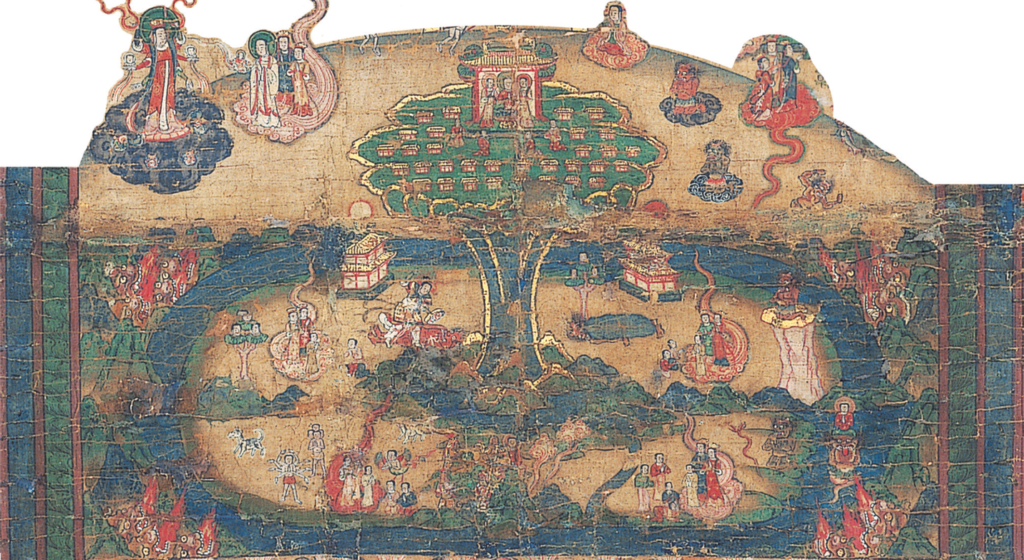
Thirty-two palaces at the top of Sumēru surround a larger palace of Deity, pictured with an attendant on either side. The four pleading figures who kneel around the throne may represent either the bringing of a judicial complaint from the earth itself or a request for mercy for the repentant wicked before the heavenly judge.
Four archangels mentioned in BG, who (in the Manichaean conception) led the battles against the wicked and gathered the repentant to divinely prepared cities, are clothed in armor in front of a seated deity—likely Enoch—below the smaller green mountains at the foot of Mount Sumēru. In other parts of the painting that depict the “ten firmaments of the sky,” wicked “demons” (identified elsewhere in the ancient Enoch literature as “Watchers”) are imprisoned.
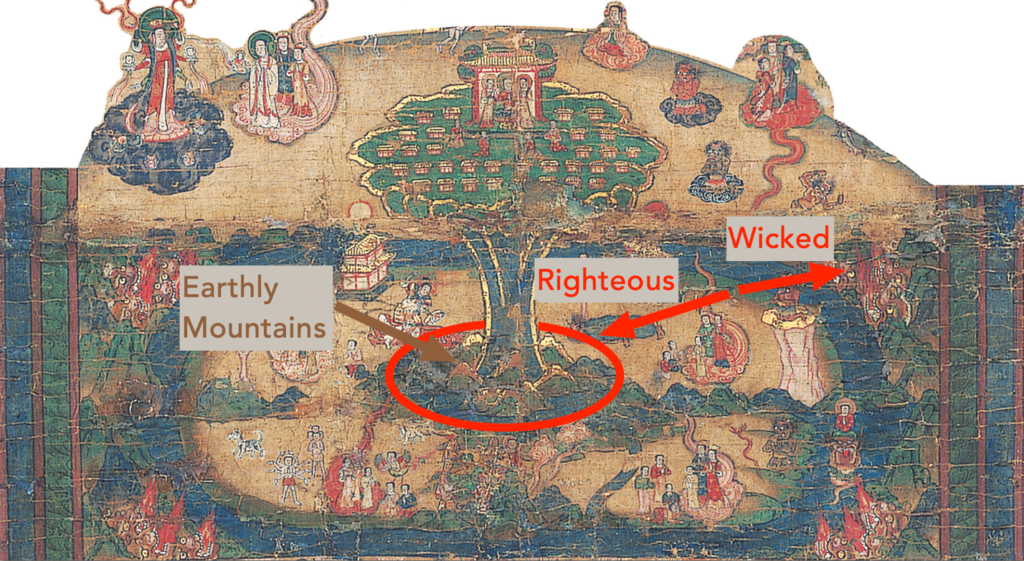
Gathering to the West and Dispersal to the East (7:16–17)
In one of the most significant resemblances of BG to the Book of Moses, we are told in both texts that the righteous were gathered to a place of safety. So far as scholars have been able to determine, the theme appears nowhere else in the ancient Enoch literature.
Latter-day Saint readers will recall the Book of Moses description of this place of safety. We read that “the Lord came and dwelt with his people. … And Enoch … built a city that was called the City of Holiness, even Zion” (Moses 7:16, 19). One interesting feature of the Manichaean BG fragments is that they tell us the direction that Enoch’s people traveled. Specifically, according to BG, four angels ultimately led the wicked to their eventual destruction in the east—away from the “sacred center”—while the righteous went westward to inhabit cities near the foot of the holy mountain, as indicated by the annotations on the figure above:
And the angels themselves descended from the heaven to the earth. … And they led one half of them eastwards, and the other half westwards, on the skirts of four huge mountains, towards the foot of the Sumēru mountain, into thirty-two[18] towns which the Living Spirit had prepared for them in the beginning.
While some Manichaean traditions suggest that both the eastward and westward bound groups were wicked,[19] BG scholar Matthew Goff sees it as more reasonable to view the westward bound group in BG as repentant gibborim, reminding readers that the area near Mount Sumēru is the sacred omphalos mundi (“navel of the world”)[20] of Indian tradition”:[21]
No reason is given as to why the [gibborim] are placed in cities. The division of the [gibborim] along an east-west axis suggests two opposed fates for them—one half was killed and the other survived. This could be explained by positing that some of the [gibborim] repented and changed their ways while others did not.
In the symbolic account of the geographical history of the two opposing groups, BG describes the righteous dwelling “westwards, on the skirts of four huge mountains.”[22] Significantly, this imagery recalls Moses 7:17, which relates that the righteous “were blessed upon the mountains, and upon the high places, and did flourish.” Where in all the ancient Enoch tradition do we find the remarkably similar story of the gathering of Enoch’s converts to a community of refuge in the mountains? Only in the Book of Giants and the Book of Moses.
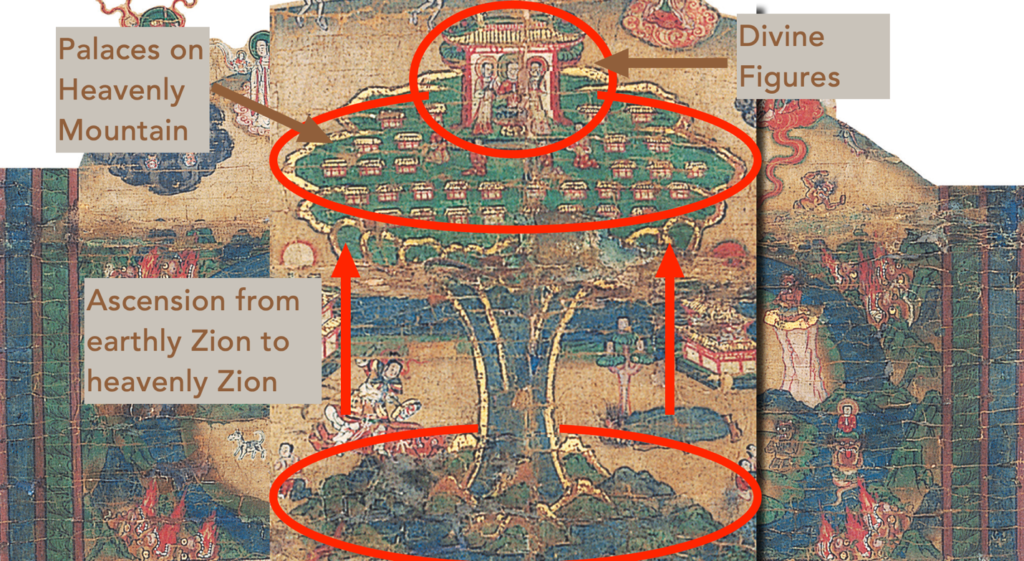
Zion Is Fled (Moses 7:69)
Are there any traces of the heavenly ascent of Enoch’s people in BG? Yes, but the answer requires some explaining.
BG scholar Gåbor Kósa sees the thirty-two palaces, shown “on the ‘foliage’ [at the top] of the tree-like Mount Sumēru,” as implying “a divine association; this is reinforced by the presence of three divine figures in front of the [much bigger] thirty-third palace, with the central figure seated on a lotus throne and the two [attendants] standing on either side. All in all, this seems to indicate the purely divine nature of this Manichaean Mount Sumēru.”[24] In addition, Kósa sees the description of the mountain with its tree-like iconography as resonating with the description of the mountain of God and the Tree of Life in 1 Enoch 25:2–4:[25]
Then I answered him—I, Enoch—and said, “concerning all things I wish to know, but especially concerning this tree.”
And he answered me and said, “this high mountain that you saw, whose peak is like the throne of God, is the seat where the Great Holy One, the Lord of glory, the King of eternity, will sit, when he descends to visit the earth in goodness. And (as for) this fragrant tree, no flesh has the right to touch it until the great judgment, in which there will be vengeance on all and a consummation forever.
The scene also evokes the imagery of Nephi’s vision (1 Nephi 11:1, 3, 4,8, 25):
I was caught away … into an exceedingly high mountain …
And I said: I desire to behold the things which my father saw.
And the Spirit said unto me: Believest thou that thy father saw the tree of which he hath spoken? …
And I looked and beheld a tree; … and the beauty thereof was far beyond, yea, exceeding of all beauty. …
And I … beheld that the tree of life was a representation of the love of God.
Going further, though Kósa recognizes an obvious correspondence of some kind between the visual depiction of thirty-two palaces at the top of Mount Sumēru and the report in the BG text of “thirty-two towns” for the repentant gibborim at the base of Mount Sumēru he finds it difficult to reconcile the fact that the palaces shown at the top within MCP “are definitely not towns; [neither are they] at the foot of the mountains” as is described in the text of BG.[26]
In trying to unravel these anomalies, we should recall that the Book of Moses chronicles a transformation of the earthly Zion, symbolically located in the foothills of the “mountain of the Lord,” into a heavenly Zion, as shown in the annotated figure above. In this way, the redemptive descensus initiated by Jared and his brethren culminated in the glorious ascensus led by Enoch:
And Enoch and all the people walked with God, and he dwelt in the midst of Zion; and it came to pass that Zion was not, for God received it up into his own bosom; and from thence went forth the saying, Zion is Fled.

The Lord and Enoch’s City will Receive the Righteous (7:63)
As mentioned at the beginning of this article, Enoch’s heavenly Zion is slated to return and be made one with earthly Zion. N. T. Wright, the well-known Anglican bishop and New Testament scholar, described the uniting of heaven and earth as follows:[28]
God made heaven and earth; at last he will remake both and join them together forever. And when we come to the picture of the actual end in Revelation 21–22, we find not ransomed souls making their way to a disembodied heaven but rather the new Jerusalem coming down from heaven to earth, uniting the two in a lasting embrace.
Again, the ancient Enoch literature echoes the themes of the Book of Moses. In the Parables of Enoch 45:4–5 we read:[29] “On that day, I shall make my Chosen One dwell among them, and I shall transform heaven and make it a blessing and a light forever; and I shall transform the earth and make it a blessing. And my chosen ones I shall make to dwell on it.”
Moses 7:63 shares similar imagery with Psalm 85—and this time 1 Enoch does the same. However, as in the previous instance, there is an important difference. In Psalm 85 and 1 Enoch, two divine attributes meet and kiss, whereas in Moses 7:63 it is Enoch’s city and the Lord Himself that fall upon the necks of the righteous and kiss them, as they would a returning prodigal.[30]
| Moses 7:63 | Psalm 85:10 | 1 Enoch 11:2 |
| And we will fall upon their necks, and they shall fall upon our necks, and we will kiss each other. | Mercy and truth are met together; righteousness and peace have kissed each other. | Truth and peace will be united together.[31] |
Robert Alter, writing of Psalm 85, captures the commonality of spirit with Moses 7:63:[32] “This bold metaphor focuses the sense of an era of perfect loving harmony. Rashi imagines a landscape in which all Israelites will kiss one another.”
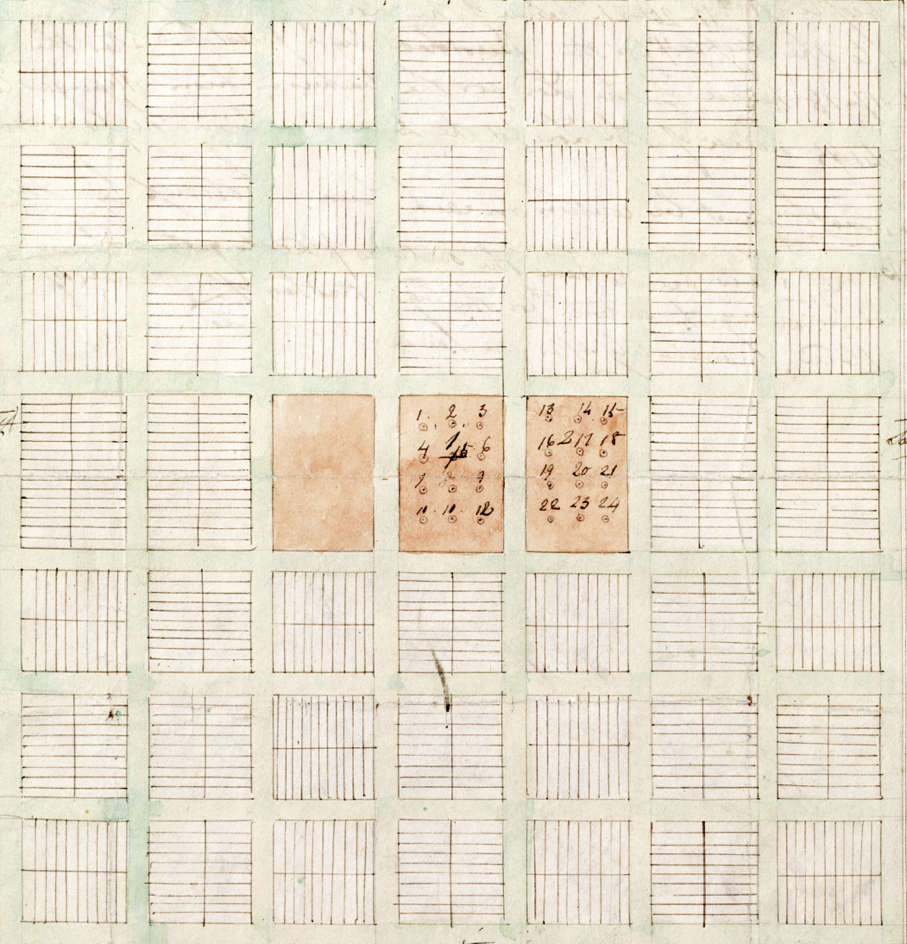
Latter-day Zion
Whether or not by sheer coincidence, the symbolic geography shared by the Manichaean BG fragments and Manichaean Cosmology Painting (MCP) are mirrored in a general way in the itinerary of the gathering and the layout for Joseph Smith’s City of Zion in Missouri. This latter-day city is described in modern scripture in close connection with descriptions of Enoch’s ancient city (see, for example, Doctrine and Covenants 45:11–14). As the righteous of Enoch’s day were remembered by BG as having been divinely led westward, so the early Saints were told by the Lord: “gather ye out from the eastern lands” and “go ye forth into the western countries” (Doctrine and Covenants 45:64, 66).
Moreover, in both cases the destination of the western movement of each group is identified as a unique hierocentric location: for Enoch’s people that location was Mount Sumēru in the middle of the world map, while for the early Saints that location was “Mount Zion, which shall be the city of New Jerusalem” (Doctrine and Covenants 84:2, emphasis added), a relatively central location on the North American continent. Significantly, the city of New Jerusalem envisioned by the Saints is expressly called in revelation, “the center place” (Doctrine and Covenants 57:3) or “center stake.”[34]
Finally, while MCP depicts Mount Sumēru with thirty-two or thirty-six palaces at its summit, the plat for the city of Zion prominently featured twenty-four numbered temple sites at its center. Thus, in the MCP depiction of BG, in the Book of Moses, and in the envisioned latter-day City of Zion, “God … dwelt in the midst,” literally and symbolically central in the eyes of His people.
Conclusion
What a blessing it is to live in a day when we are preparing for the return of Zion. May each of us “embrace the truth and look upward” (JST Genesis 9:22) so that we may be ready for that day is my prayer.
More Come, Follow Me resources here.
References
Addams, R. Jean. “The past and the future of the Temple Lot in Jackson County, Missouri.” In The Temple: Past, Present, and Future. Proceedings of the Fifth Interpreter Foundation Matthew B. Brown Memorial Conference, 7 November 2020, edited by Stephen D. Ricks and Jeffrey M. Bradshaw. Temple on Mount Zion 6, 31–96. Orem and Salt Lake City, UT: The Interpreter Foundation and Eborn Books, 2021. https://journal.interpreterfoundation.org/the-past-and-future-of-the-temple-lot-in-independence-jackson-county-missouri/. (accessed May 19, 2021).
Alter, Robert, ed. The Hebrew Bible: A Translation with Commentary. New York City, NY: W. W. Norton, 2019.
Bradshaw, Jeffrey M., and Ryan Dahle. “Could Joseph Smith have drawn on ancient manuscripts when he translated the story of Enoch? Recent updates on a persistent question (4 October 2019).” Interpreter: A Journal of Latter-day Saint Faith and Scholarship 33 (2019): 305-73. https://interpreterfoundation.org/could-joseph-smith-have-drawn-on-ancient-manuscripts-when-he-translated-the-story-of-enoch-recent-updates-on-a-persistent-question/. (accessed October 23, 2019).
Bradshaw, Jeffrey M. Enoch and the Gathering of Zion: The Witness of Ancient Texts for Modern Scripture. Orem, Springville, and Salt Lake City, UT: The Interpreter Foundation, Book of Mormon Central, and Eborn Books, 2021. https://interpreterfoundation.org/books/enoch-and-the-gathering-of-zion/. (accessed September 11, 2021).
———. “Moses 6–7 and the Book of Giants: Remarkable Witnesses of Enoch’s Ministry.” In Tracing Ancient Threads in the Book of Moses: Inspired Origins, Temple Contexts, and Literary Qualities, edited by Jeffrey M. Bradshaw, David R. Seely, John W. Welch and Scott Gordon, 1041–256. Orem, UT; Springville, UT; Redding, CA; Tooele, UT: The Interpreter Foundation, Book of Mormon Central, FAIR, and Eborn Books, 2021. https://www.youtube.com/watch?v=HP6GYxbieNQ ; https://journal.interpreterfoundation.org/moses-6-7-and-the-book-of-giants ; http://templethemes.net/publications/210911-Bradshaw-jmb-s.pdf.
———. “Since Hugh Nibley: Remarkable New Findings on Enoch and the Gathering of Zion.” Presented at the 2021 FAIR Conference, Provo, UT, August 4, 2021. https://www.fairlatterdaysaints.org/conference/august-2021. (accessed September 11, 2021).
Bushman, Richard Lyman. Joseph Smith: Rough Stone Rolling, A Cultural Biography of Mormonism’s Founder. New York City, NY: Alfred A. Knopf, 2005.
———. “Hugh Nibley and Joseph Smith.” Journal of the Book of Mormon and Other Restoration Scripture 19, no. 1 (2010): 4-13. https://scholarsarchive.byu.edu/jbms/vol19/iss1/3. (accessed July 28, 2019).
Frölich, Ida. “Giants and demons.” In Ancient Tales of Giants from Qumran and Turfan: Contexts, Traditions, and Influences, edited by Matthew Goff, Loren T. Stuckenbruck and Enrico Morano. Wissenschlaftliche Untersuchungen zum Neuen Testament 360, ed. Jörg Frey, 97–114. Tübingen, Germany: Mohr Siebeck, 2016.
Gardner, Iain, ed. The Kephalaia of the Teacher: The Edited Coptic Manichaean Texts in Translation with Commentary. Nag Hammadi and Manichaean Studies 37, ed. James M. Robinson and H. J. Klimkeit. Leiden, The Netherlands: E. J. Brill, 1995.
Givens, Terryl L., and Fiona Givens. The God Who Weeps: How Mormonism Makes Sense of Life. Salt Lake City, UT: Ensign Peak, 2012.
Goff, Matthew. “The sons of the Watchers in the Book of Watchers and the Qumran Book of Giants.” In Ancient Tales of Giants from Qumran and Turfan: Contexts, Traditions, and Influences, edited by Matthew Goff, Loren T. Stuckenbruck and Enrico Morano. Wissenschlaftliche Untersuchungen zum Neuen Testament 360, ed. Jörg Frey, 115-27. Tübingen, Germany: Mohr Siebeck, 2016.
Gulácsi, Zsuzsanna, and Jason BeDuhn. “Picturing Mani’s Cosmology: An analysis of doctrinal iconography on a Manichaean hanging scroll from 13th/14th-century southern China.” Bulletin of the Asia Institute 25 (2011/2015): 55–105. https://www.academia.edu/28622292/_Picturing_Mani_s_Cosmology_An_Analysis_of_Doctrinal_Iconography_on_a_Manichaean_Hanging_Scroll_from_13th_14th_century_Southern_China_Bulletin_of_the_Asia_Institute_25_2011_2015_55_105_coauthored_with_Jason_BeDuhn (article) ; http://www.bulletinasiainstitute.org/abst/vol25/Gulacsi.html (abstract). (accessed December 15, 2021).
Gulácsi, Zsuzsanna. Mani’s Pictures: The Didactic Images of the Manichaeans from Sasanian Mesopotamia to Uygur Central Asia and Tang-Ming China. Nag Hammadi and Manichaean Studies 90. Leiden, The Netherlands: Brill, 2015. https://www.academia.edu/28945654/_Introduction_to_MANI_S_PICTURES_The_Didactic_Images_of_the_Manichaeans_from_Sasanian_Mesopotamia_to_Uygur_Central_Asia_and_Tang_Ming_China_Leiden_Brill_2015_pp_1_19. (accessed December 18, 2021).
Henning, W. B. “The Book of the Giants.” Bulletin of the School of Oriental and African Studies, University of London 11, no. 1 (1943): 52-74. https://www.cambridge.org/core/journals/bulletin-of-the-school-of-oriental-and-african-studies/article/book-of-the-giants/F09AF3F19C427A250B9D562F82640944. (accessed January 25, 2018).
Holland, Jeffrey R. 2017. The greatness of the evidence (Talk given at the Chiasmus Jubilee, Joseph Smith Building, Brigham Young University, Provo, UT, 16 August 2017). In Mormon Newsroom. http://www.mormonnewsroom.org/article/transcript-elder-holland-speaks-book-of-mormon-chiasmus-conference-2017. (accessed August 18, 2017).
Kósa, Gåbor. “The Book of Giants tradition in the Chinese Manichaica.” In Ancient Tales of Giants from Qumran and Turfan: Contexts, Traditions, and Influences, edited by Matthew Goff, Loren T. Stuckenbruck and Enrico Morano. Wissenschlaftliche Untersuchungen zum Neuen Testament 360, ed. Jörg Frey, 145-86. Tübingen, Germany: Mohr Siebeck, 2016. https://www.researchgate.net/publication/325807703_The_Book_of_Giants_tradition_in_the_Chinese_Manichaica. (accessed December 8, 2021).
Manichaean Diagram of the Universe. In Wikipedia. https://en.wikipedia.org/wiki/Manichaean_Diagram_of_the_Universe. (accessed December 15, 2021).
Nibley, Hugh W. “A strange thing in the land: The return of the Book of Enoch, part 13.” Ensign 7, August 1977, 64–65. https://www.churchofjesuschrist.org/study/ensign/1977/08/a-strange-thing-in-the-land-the-return-of-the-book-of-enoch-part-13?lang=eng. (accessed March 23, 2021).
———. Enoch the Prophet. The Collected Works of Hugh Nibley 2. Salt Lake City, UT: Deseret Book, 1986. https://archive.org/details/thesaurustemporu00euse/page/n793/mode/2up?q=animadversiones. (accessed November 25, 2021).
———. 1952. Lehi in the Desert, The World of the Jaredites, There Were Jaredites. The Collected Works of Hugh Nibley 5. Salt Lake City, UT: Deseret Book, 1988.
Nickelsburg, George W. E., ed. 1 Enoch 1: A Commentary on the Book of 1 Enoch, Chapters 1-36; 81-108. Hermeneia: A Critical and Historical Commentary on the Bible. Minneapolis, MN: Fortress Press, 2001.
Nickelsburg, George W. E., and James C. VanderKam, eds. 1 Enoch 2: A Commentary on the Book of 1 Enoch, Chapters 37-82. Hermeneia: A Critical and Historical Commentary on the Bible. Minneapolis, MN: Fortress Press, 2012. https://archive.org/details/1enochcommentary0002nick. (accessed October 28, 2021).
Rashi. c. 1105. Rashi’s Commentary on Psalms. Translated by Mayer I. Gruber. The Brill Reference Library of Judaism 18. Philadelphia, PA: The Jewish Publication Society, 2007.
Reeves, John C. Jewish Lore in Manichaean Cosmogony: Studies in the Book of Giants Traditions. Monographs of the Hebrew Union College 14. Cincinnati, OH: Hebrew Union College Press, 1992. https://books.google.com/books?id=SvaKDwAAQBAJ.
Wilkens, Jens. “Remarks on the Manichaean Book of Giants: Once again on Mahaway’s mission to Enoch.” In Ancient Tales of Giants from Qumran and Turfan: Contexts, Traditions, and Influences, edited by Matthew Goff, Loren T. Stuckenbruck and Enrico Morano. Wissenschlaftliche Untersuchungen zum Neuen Testament 360, ed. Jörg Frey, 213-29. Tübingen, Germany: Mohr Siebeck, 2016.
Wright, Nicholas Thomas. Surprised by Hope: Rethinking Heaven, the Resurrection, and the Mission of the Church. New York City, NY: HarperOne, 2008.
Young, Brigham. 1874. “Discourse by President Brigham Young, delivered in the Third Ward Meeting HOuse, Salt Lake City, Sunday evening, June 23, 1874. Secret of happiness; self examination; Joseph Smith a man of obedience to God; baptism for the dead; temporal and spiritual one; a dream; order of Enoch, the order of God; a good word for the women.” In Journal of Discourses. 26 vols. Vol. 18, 235–49. Liverpool and London, England: Latter-day Saints Book Depot, 1853-1886. Reprint, Salt Lake City, UT: Bookcraft, 1966.
Endnotes
[1] https://www.thechurchnews.com/leaders-and-ministry/2022-01-01/president-russell-m-nelson-suggests-3-resolutions-in-his-first-message-of-2022-238652 .
[2] https://artuk.org/discover/artworks /stained-glass-design-enoch-19147/search/actor:shields-frederick -james-18331911/page/2 (accessed May 2, 2020). Photo credit: Wolverhampton Arts and Heritage.
[3] https://www.thechurchnews.com/leaders-and-ministry/2022-01-01/president-russell-m-nelson-suggests-3-resolutions-in-his-first-message-of-2022-238652 .
[4] Compare H. W. Nibley, Lehi 1988, p. 114; R. L. Bushman, Hugh Nibley and Joseph Smith, p. 102.
[5] J. R. Holland, Greatness of the Evidence.
[6] The concluding article of Nibley’s long-running series on Enoch in the Church’s Ensign magazine appeared in H. W. Nibley, Strange Thing, Part 13. These and other essays were eventually published in H. W. Nibley, Enoch.
[7] Detailed account of these discoveries and their implications can be found in J. M. Bradshaw, Enoch and the Gathering of Zion; J. M. Bradshaw, Moses 6–7 and the Book of Giants.
[8] J. M. Bradshaw, Since Hugh Nibley.
[9] Latter-day Saint historian Richard L. Bushman concluded that “it is scarcely conceivable that Joseph Smith knew of Laurence’s Enoch translation, but the coincidence of their appearance within a few years of each is a curiosity. Laurence’s 105 translated chapters do not resemble Joseph Smith’s Enoch in any obvious way” (R. L. Bushman, Rough Stone, p. 138). For more detailed analysis of the availability of these texts to Joseph Smith, see, e.g., J. M. Bradshaw et al., Could Joseph Smith Have Drawn (2019).
[10] For these and other thematic resemblances, see the detailed references to the Book of Giants included in J. M. Bradshaw, Moses 6–7 and the Book of Giants; J. M. Bradshaw, Enoch and the Gathering of Zion.
[11] See, for example, this sense of gibborim in Moses 8:21 (the children of the self-proclaimed “sons of God”), Genesis 10:8–9 (Nimrod), Genesis 10:25 (Peleg), and Genesis 11:4 (the builders of the Tower of Babel who wanted to make themselves a name).
[12] Namely, G. W. E. Nickelsburg, 1 Enoch 1, 7:3, p. 182. See Nickelsburg’s views on the implications of this verse on p. 186.
[13] I. Frölich, Giants and Demons,” 106–7.
[14] Manichaean Diagram of the Universe, Manichaean Diagram of the Universe.
[15] Z. Gulácsi et al., Picturing Mani’s Cosmology, abstract.
[16] Z. Gulácsi, Mani’s Pictures, p. 470.
[17] Ibid., p. 470.
[18] Some texts report thirty-six towns— see, for example, comments in W. B. Henning, Book of the Giants, pp. 55–56 comparing text S to text G. Compare I. Gardner, Kephalaia, chap. 45 (codex 117, lines 5-8), p. 123 which also speaks of thirty-six towns. See also J. C. Reeves, Jewish Lore, p. 160n386; J. Wilkens, Remarks, pp. 220–21.
[19] Gardner summarizes the view of Kephalaia that all those described in this passage were wicked (I. Gardner, Kephalaia, p. 122. See also Z. Gulácsi, Mani’s Pictures, 273):
The point of this chapter is the foreknowledge of the powers of light that has enabled them to prepare places to hold and contain various evil forces that arise during cosmic history, … [including] a prison for the Watchers; cities for the giants of old.
[20] Compare J. C. Reeves, Jewish Lore, p. 160n385:
According to Indian tradition, Mount Mēru or Sumēru (“Good Mēru) was the great mountain which stood at the center of the earth. See Mahābhārata 1(5) 15.5ff.: … “The great mountain rises aloft to cover with its heights the vault of heaven.”
[21] M. Goff, Sons of the Watchers, p. 125
[22] W. B. Henning, Book of the Giants, text G (Sogdian), p. 69.
[23] Z. Gulácsi, Mani’s Pictures, p. 470.
[24] G. Kósa, Book of Giants Tradition, p. 172.
[25] G. W. E. Nickelsburg, 1 Enoch 1, 25:2–4, p. 312.
[26] G. Kósa, Book of Giants Tradition, pp. 171–72.
[27] With permission of the artist.
[28] N. T. Wright, Surprised, p. 19.
[29] G. W. E. Nickelsburg et al., 1 Enoch 2, 45:4–5, p. 148.
[30] Terryl and Fiona Givens comment (T. L. Givens et al., God Who Weeps, p. 106):
The beauty and power of this image is in its concreteness. God and His people, the living and the departed, heaven and earth, embrace. The immense distance between the spiritual and the mundane collapses, and we find holiness in the ordinary. Luke’s tale of the prodigal son turns out to be not symbolic foreshadowing, but literal foretaste, of a greater reunion. As the evangelist told the story, when the son ‘was yet a great way off, his father saw him, and had compassion, and ran, and fell on his neck, and kissed him’ (Luke 15:20).”
[31] G. W. E. Nickelsburg, 1 Enoch 1, 11:2, p. 216.
[32] R. Alter, Hebrew Bible, Psalm 85:[12], justice and peace have kissed, 3:206. “Rashi construes biblical Hebrew ṣedeq ‘JUSTICE’ in the sense of Rabbinic Hebrew ṣĕdāqāh ‘charity’” (Rashi, Psalms, p. 554 n. 12), and comments (ibid., p. 553å):
The charity [haṣṣĕdāqāh] which Israel used to perform and the WELL-BEING from the Holy One Blessed be He will kiss each other, which is to say that the end result of charity is well-being [that is, šālôm, translated in the KJB as “peace”].
[33] Church History Library, MS 2567. Original drawing prepared at the direction of Joseph Smith, Jr. in Kirtland, Ohio, in 1833 by Frederick G. William and mailed to Edward Partridge and others in Independence, Missouri, in June 1833. MS_2567_f0001-Plat_of_city_of_Zion__1833-ORIGINAL.pdf. https://catalog.churchofjesuschrist. org/record?id=c5d54bd0-bede-47cb-b636-3281f30b0d0a (accessed May 19, 2021). Elder Alvin R. Dyer observed that the dimensions of the drawing of the Prophet’s proposed temple structures for Zion were 61’0” x 87’0’, thus matching the dimensions of the Latter-day Saints Visitors Center, finished in 1981 and located on part of the Independence Temple Lot owned by the Church (Alvin R. Dyer, “Report of Meeting with President David O. McKay,” diary, March 10, 1967, accn. 1334, box 46, f 6, cited in R. J. Addams, Past and Future of the Temple Lot (TMZ 2020), p. 65).
[34] B. Young, 23 June 1874, p. 242.
 Jeffrey M. Bradshaw (PhD, Cognitive Science, University of Washington) is a Senior Research Scientist at the Florida Institute for Human and Machine Cognition (IHMC) in Pensacola, Florida (www.ihmc.us/groups/jbradshaw; en.wikipedia.org/wiki/Jeffrey_M._Bradshaw). His professional writings have explored a wide range of topics in human and machine intelligence (www.jeffreymbradshaw.net). Jeff has been the recipient of several awards and patents and has been an adviser for initiatives in science, defense, space, industry, and academia worldwide. Jeff has written detailed commentaries on the Book of Moses and Genesis 1–11 and on temple themes in the scriptures. For Church-related publications, see www.TempleThemes.net. Jeff was a missionary in France and Belgium from 1975–1977, and his family has returned twice to live in France. He and his wife, Kathleen, are the parents of four children and fourteen grandchildren. From July 2016-September 2019, Jeff and Kathleen served missions in the Democratic Republic of Congo Kinshasa Mission office and the DR Congo Kinshasa Temple. They currently live in Nampa, Idaho.
Jeffrey M. Bradshaw (PhD, Cognitive Science, University of Washington) is a Senior Research Scientist at the Florida Institute for Human and Machine Cognition (IHMC) in Pensacola, Florida (www.ihmc.us/groups/jbradshaw; en.wikipedia.org/wiki/Jeffrey_M._Bradshaw). His professional writings have explored a wide range of topics in human and machine intelligence (www.jeffreymbradshaw.net). Jeff has been the recipient of several awards and patents and has been an adviser for initiatives in science, defense, space, industry, and academia worldwide. Jeff has written detailed commentaries on the Book of Moses and Genesis 1–11 and on temple themes in the scriptures. For Church-related publications, see www.TempleThemes.net. Jeff was a missionary in France and Belgium from 1975–1977, and his family has returned twice to live in France. He and his wife, Kathleen, are the parents of four children and fourteen grandchildren. From July 2016-September 2019, Jeff and Kathleen served missions in the Democratic Republic of Congo Kinshasa Mission office and the DR Congo Kinshasa Temple. They currently live in Nampa, Idaho.
The post Come, Follow Me Week 5 – Moses 7 appeared first on FAIR.
Continue reading at the original source →



